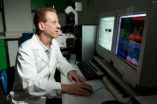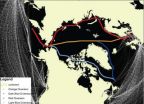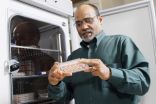Microwave oven key to self-assembly process meeting semi-conductor industry need
Decrease in self-assembly processing time creates viable alternative to conventional lithography
2010-10-26
(Press-News.org) Thanks to a microwave oven, the fundamental nanotechnology process of self assembly may soon replace the lithographic processing use to make the ubiquitous semi-conductor chips. By using microwaves, researchers at Canada's National Institute for Nanotechnology (NINT) and the University of Alberta have dramatically decreased the cooking time for a specific molecular self-assembly process used to assemble block copolymers, and have now made it a viable alternative to the conventional lithography process for use in patterning semi-conductors. When the team of chemists and electrical engineering researchers replaced convective heat with a microwave oven, nano-sized particles were encouraged to organize themselves into very regular patterns extremely quickly – reducing the processing time from days to less than one minute.
The processing time is very important if this self-assembly process is to be introduced to industrial semi-conductor fabrication. In the International Technology Roadmap for Semiconductors, the promise of self-assembly to address the need to put more and more functionality onto chips was recognized. The block co-polymer method, which directs nanomaterials to create molds and then fills them in with a target material, was known to be capable of creating very detailed patterns many times smaller than current technology. But previously the time needed for molecules to organize themselves was too long to be useful for the industry. The change of the heat source has brought that processing time well under the suggested target of 4 minutes.
"This is one of the first examples of the self-assembly process being used to address a real world problem for the semi-conductor industry," said Dr. Jillian Buriak "We've got the process; the next step is to exploit it to make something useful."
INFORMATION:
The process for quicker assembly is outlined in new paper in the American Chemical Society's ACS Nano, posted on-line October 21, 2010. http://pubs.acs.org/doi/abs/10.1021/nn102387c
ELSE PRESS RELEASES FROM THIS DATE:
2010-10-26
Turning up the heat might be the best thing for athletes competing in cool weather, according to a new study by human physiology researchers at the University of Oregon.
Published in the October issue of the Journal of Applied Physiology, the paper examined the impact of heat acclimation to improve athletic performance in hot and cool environments.
Researchers conducted exercise tests on 12 highly trained cyclists -- 10 males and two females -- before and after a 10-day heat acclimation program. Participants underwent physiological and performance tests under both ...
2010-10-26
HOUSTON, Oct. 25, 2010 – Some unexpected effects of lead exposure that may one day help prevent and reverse blindness have been uncovered by a University of Houston (UH) professor and his team.
Donald A. Fox, a professor of vision sciences in UH's College of Optometry (UHCO), described his team's findings in a paper titled "Low-Level Gestational Lead Exposure Increases Retinal Progenitor Cell Proliferation and Rod Photoreceptor and Bipolar Cell Neurogenesis in Mice," published recently online in Environmental Health Perspectives and soon to be published in the print ...
2010-10-26
WEST LAFAYETTE, Ind. - Greenhouse plant growers can substitute rice hulls for perlite in their media without the need for an increase in growth regulators, according to a Purdue University study.
Growing media for ornamental plants often consists of a soilless mix of peat and perlite, a processed mineral used to increase drainage. Growers also regularly use plant-growth regulators to ensure consistent and desired plant characteristics such as height to meet market demands. Organic substitutes for perlite like tree bark have proven difficult because they absorb the plant-growth ...
2010-10-26
As the ice-capped Arctic Ocean warms, ship traffic will increase at the top of the world. And if the sea ice continues to decline, a new route connecting international trading partners may emerge -- but not without significant repercussions to climate, according to a U.S. and Canadian research team that includes a University of Delaware scientist.
Growing Arctic ship traffic will bring with it air pollution that has the potential to accelerate climate change in the world's northern reaches. And it's more than a greenhouse gas problem -- engine exhaust particles could ...
2010-10-26
GAINESVILLE, Fla. — New University of Florida research puts to rest the mystery of where old carbon was stored during the last glacial period. It turns out it ended up in the icy waters of the Southern Ocean near Antarctica.
The findings have implications for modern-day global warming, said Ellen Martin, a UF geological sciences professor and an author of the paper, which is published in this week's journal Nature Geoscience.
"It helps us understand how the carbon cycle works, which is important for understanding future global warming scenarios," she said. "Ultimately, ...
2010-10-26
WEST LAFAYETTE, Ind. - Researchers found a previously unmapped fault was responsible for the devastating Jan. 12 earthquake in Haiti and that the originally blamed fault remains ready to produce a large earthquake.
Eric Calais, a Purdue University professor of earth and atmospheric sciences, led the team that was the first on the ground in Haiti after the magnitude 7.0 earthquake, which killed more than 200,000 people and left 1.5 million homeless.
The team determined the earthquake's origin is a previously unmapped fault, which they named the LÄogëne fault. The newly ...
2010-10-26
CHICAGO, Oct. 25, 2010 – Young children who consume substantial amounts of fluoride through infant formula and other beverages mixed with fluoridated water or by swallowing fluoride toothpaste have an increased chance of developing mild enamel fluorosis, according to research published in the October issue of The Journal of the American Dental Association and supported by the National Institute of Dental and Craniofacial Research. Children can continue using fluoridated water and fluoride toothpaste because fluoride has been proven to prevent tooth decay, and mild fluorosis ...
2010-10-26
While most commonly associated with mononucleosis, Epstein-Barr virus (EBV) has been linked to many diseases that affect people long after the initial infection takes place, including some forms of cancer. In the current issue of the Journal of Biological Chemistry, scientists at The Wistar Institute describe how viral microRNA – small segments of RNA that suppress the effects of gene activity – allows EBV to hide within cells and evade the immune system. The scientists believe their findings may one day enable physicians to flush EBV out of hiding, allowing a healthy immune ...
2010-10-26
CAMBRIDGE, Mass. -- Researchers at MIT have revealed exactly how a molecule called fulvalene diruthenium, which was discovered in 1996, works to store and release heat on demand. This understanding, reported in a paper published on Oct. 20 in the journal Angewandte Chemie, should make it possible to find similar chemicals based on more abundant, less expensive materials than ruthenium, and this could form the basis of a rechargeable battery to store heat rather than electricity.
The molecule undergoes a structural transformation when it absorbs sunlight, putting it into ...
2010-10-26
WEST LAFAYETTE, Ind. - Pathogenic listeria tricks intestinal cells into helping it pass through those cells to make people ill, and, if that doesn't work, the bacteria simply goes around the cells, according to a Purdue University study.
Arun Bhunia, a professor of food science, and Kristin Burkholder, a former Purdue graduate student who is now a postdoctoral researcher in microbiology and immunology at the University of Michigan Medical School, found that listeria, even in low doses, somehow triggers intestinal cells to express a new protein, heat shock protein 60, ...
LAST 30 PRESS RELEASES:
[Press-News.org] Microwave oven key to self-assembly process meeting semi-conductor industry need
Decrease in self-assembly processing time creates viable alternative to conventional lithography




